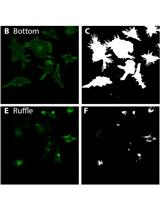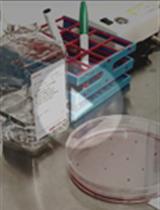- Submit a Protocol
- Receive Our Alerts
- EN
- EN - English
- CN - 中文
- Protocols
- Articles and Issues
- For Authors
- About
- Become a Reviewer
- EN - English
- CN - 中文
- Home
- Protocols
- Articles and Issues
- For Authors
- About
- Become a Reviewer
Retrovirus Mediated Malignant Transformation of Mouse Embryonic Fibroblasts
Published: Vol 3, Iss 15, Aug 5, 2013 DOI: 10.21769/BioProtoc.844 Views: 10599
Reviewed by: Lin FangFanglian He

Protocol Collections
Comprehensive collections of detailed, peer-reviewed protocols focusing on specific topics
Related protocols

Lentiviral shRNA Screen to Identify Epithelial Integrity Regulating Genes in MCF10A 3D Culture
Elsa Marques and Juha Klefström
Dec 5, 2016 10462 Views

Automated Analysis of Cell Surface Ruffling: Ruffle Quantification Macro
Nicholas D. Condon [...] Adam A. Wall
Jan 20, 2020 3933 Views

A Fast and Reliable Method to Generate Pure, Single Cell-derived Clones of Mammalian Cells
Zhe Han [...] Varun Kumar
Aug 20, 2022 2100 Views
Abstract
Cellular transformation is a widely used method to artificially induce cells to form tumours in vivo. Here, we describe the methodology for malignant transformation of mouse embryonic fibroblasts (MEFs) for transplantation into immunodeficient nude mice, as used in Leong et al. (2013). The two-step process involves: 1) down-regulation of Trp53 expression using a short hairpin RNA (shRNA); and 2) overexpression of the oncogenic HRasV12 protein. Reduction of Trp53 expression leads to cell immortalisation, and the subsequent overexpression of oncogenic HRasV12 results in malignant transformation of a cell.
Keywords: TransformationBackground
Materials and Reagents
- Source of tissue: body of embryonic day 13.5 mouse embryos, harvested fresh from pregnant females
- Dulbecco’s Modified Eagle’s Medium (DMEM) (Life Technologies, Gibco®, catalog number: 41965-039 )
- Fetal Calf Serum (FCS) (Life Technologies, Gibco®, catalog number: 10437-028 )
- Trypsin (Life Technologies, Gibco®, catalog number: 25200056 )
- Dulbecco’s Phosphate Buffered Saline (PBS), without Ca2+ and Mg2+ (Life Technologies, Gibco®, catalog number: 14190-144 )
- Retroviral supernatant containing LMP-p53.1224 shRNA construct (Dickins et al., 2005)
- Retroviral supernatant containing pWZL-HRasV12 cDNA construct (Serrano et al., 1997)
- Hygromycin B (Life Technologies, catalog number: 10687-010 )
- Puromycin (Sigma-Aldrich, catalog number: P9620-10ML )
- Hexadimethrine bromide/Polybrene (Sigma-Aldrich, catalog number: H9268 )
- Polybrene (1,000x stock) (see Recipes)
Equipment
- Tissue culture flasks T75 (Greiner Bio-One, catalog number: 658175 )
- 10-cm tissue culture dishes (BD Biosciences, Falcon®, catalog number: 353003 )
- 21-gauge needles
- 5 ml syringes
- 37 °C 10% CO2 cell culture incubator
- Table-top centrifuge
Procedure
- Retroviral supernatants are prepared as previously described, at a titer of 106 to 107 viral particle per ml of viral supernatant (Pear et al., 1993).
Note: Do not freeze/thaw supernatant, and use within 6 months. - Primary MEFs are generated from embryonic day 13.5 (E13.5) embryos by passing the embryonic body (excluding head, liver and intestines) through a 21-gauge needle and syringe followed by repeated pipetting into a 10-cm tissue culture dish (1 embryo per dish) in 1 ml of DME medium containing 10% (v/v) FCS (DMEM/FCS). It is not necessary to obtain a single cell suspension at this stage, as trypsinisation at later stages will produce a single cell suspension and excessive manipulation at this stage promotes cell death. Add 9 ml of DMEM/FCS and mix to combine.
- Primary MEFs are then incubated in 10% CO2 incubator at 37 °C for 2-3 days undisturbed.
- MEFs are washed once in PBS, trypsinised, trypsin inhibited with DMEM/FCS and pelleted at 485 g for 5 minutes.
- MEFs are split ~1:2 into a T75 tissue culture flask and incubated in 10% CO2 incubator at 37 °C overnight so that cells are ~60-70% confluent the following day.
- On the next morning, aspirate the supernatant and wash once with PBS. Combine the retroviral supernatant containing LMP-p53.1224 shRNA, DMEM/FCS and polybrene using the following recipe:
Retroviral supernatant 1.5 ml (i.e., ~1:7 dilution)
DMEM/FCS 8.5 ml
Polybrene (1,000x stock) 10 μl (4 μg/ml)
Total 10 ml - After ~7-8 h of infection, repeat step 6, and leave the fresh retroviral supernatant overnight.
- On the next day, aspirate the supernatant, wash cells once with PBS, replace with fresh DMEM/FCS, and incubate at 37 °C overnight.
- On the following day, replace medium with fresh DMEM/FCS containing 5 μg/ml puromycin (LMP-p53.1224 shRNA construct has a puromycin selectable marker), and leave for 2 days, if not confluent. Otherwise, split as necessary.
- At the end of puromycin selection on day 3, cells are washed once with PBS, trypsinised and seeded so that cells are ~60-70% confluent in a T75 flask the following day. Culture cells in DMEM/FCS without puromycin and incubate overnight at 37 °C.
- On the next day, repeat steps 6-8, but with retroviral supernatant containing pWZL-HRasV12 cDNA. The two tranductions should be performed sequentially, as suggested, so that p53 knockdown and immortalization precedes HRasV12 overexpression. This ensures the best efficiency of transformation since HRasV12 overexpression with inefficient p53 knockdown results in senescence.
- On the following day, replace medium with fresh DMEM/FCS containing 300 μg/ml hygromycin (pWZL-HRasV12 cDNA construct has a hygromycin selectable marker) for 6 days. Replace with fresh hygromycin after 3 days, and split cells when necessary.
- At the end of hygromycin selection on day 7, replace with fresh DMEM/FCS without hygromycin.
- Passage cells as necessary for another 10-14 days to allow HRasV12 to drive cell proliferation. These transformed cells can now be used for in vitro or in vivo experiments. For example, cells can be injected subcutaneously into the flank of nude mice to assess tumour growth rate in vivo. The cells can be frozen and stored in liquid nitrogen, or can be continuously passaged, however extended passaging will result in additional genetic aberrations based on the knockdown of p53.
Recipes
- 1,000x stock polybrene (4 mg/ml)
Mix 0.2 g of hexadimethrine bromide with 50 ml Milli Q H2O
Filter sterilize (0.22 μm)
Aliquot and store at -20 °C.
Acknowledgments
This protocol was previously used and adapted from Leong et al. (2013).
References
- Dickins, R. A., Hemann, M. T., Zilfou, J. T., Simpson, D. R., Ibarra, I., Hannon, G. J. and Lowe, S. W. (2005). Probing tumor phenotypes using stable and regulated synthetic microRNA precursors. Nat Genet 37(11): 1289-1295.
- Leong, H. S., Chen, K., Hu, Y., Lee, S., Corbin, J., Pakusch, M., Murphy, J. M., Majewski, I. J., Smyth, G. K., Alexander, W. S., Hilton, D. J. and Blewitt, M. E. (2013). Epigenetic regulator Smchd1 functions as a tumor suppressor. Cancer Res 73(5): 1591-1599.
- Pear, W. S., Nolan, G. P., Scott, M. L. and Baltimore, D. (1993). Production of high-titer helper-free retroviruses by transient transfection. Proc Natl Acad Sci U S A 90(18): 8392-8396.
- Serrano, M., Lin, A. W., McCurrach, M. E., Beach, D. and Lowe, S. W. (1997). Oncogenic ras provokes premature cell senescence associated with accumulation of p53 and p16INK4a. Cell 88(5): 593-602.
Article Information
Copyright
© 2013 The Authors; exclusive licensee Bio-protocol LLC.
How to cite
Leong, H. S. and Blewitt, M. (2013). Retrovirus Mediated Malignant Transformation of Mouse Embryonic Fibroblasts. Bio-protocol 3(15): e844. DOI: 10.21769/BioProtoc.844.
Category
Cancer Biology > General technique > Cell biology assays > Cellular transformation
Cell Biology > Cell isolation and culture > Transformation
Do you have any questions about this protocol?
Post your question to gather feedback from the community. We will also invite the authors of this article to respond.
Tips for asking effective questions
+ Description
Write a detailed description. Include all information that will help others answer your question including experimental processes, conditions, and relevant images.
Share
Bluesky
X
Copy link









